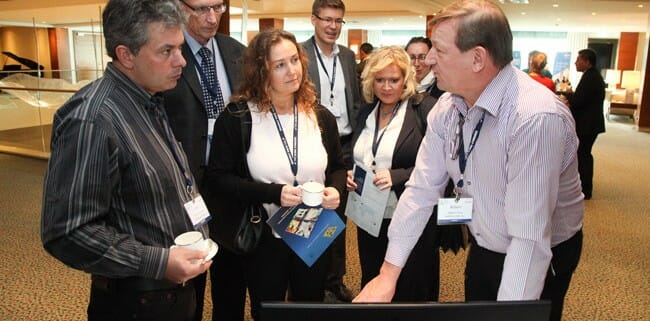Event journal: BRC Food Safety Europe Conference – Amsterdam 2013
Venturing into Europe for the first time, the BRC chose Amsterdam as their launching pad and the very hot topic of “transparency and traceability”, throughout the food chain. This topic was possibly chosen in the wake of the recent horse meat scandal, which has made Europeans demand better control over the origins of goods.
I personally, as a newbie, to the BRC conferences thought it was an excellent two days. Well organised as anticipated and to the standard one would expect of such a well-established trade association. My congratulations to all concerned.
Focus on early warning systems
It is apparent from listening to the speakers that there is now a greater emphasis placed on early warning systems which are intelligence led, and look at emerging risks and re-emerging risks. The focus is on our ability to gather intelligence, analyze data and evaluate results.
One thing to keep an eye on are the emerging issues. If we detect an emerging trend, we should evaluate whether the risk requires escalation, intervention, further investigation and recommendations for future.
I took great interest in the Emerging Risk Consultative Forum (ERCF) which is the principal body for exchanging information on emerging risks between EFSA, MS’s, EU Commission and Internal Organisations.
Furthermore, a fascinating concept that was discussed during the conference is the NIM model, which is a business model for police enforcement in UK that feeds into the Memex Patriarch system which in turn provides a data repository for gathering intelligence of any evidence of credible food safety risk… wow, where have I been?
I can redeem myself by saying I was aware of the global chain analysis i.e. Hazard Point, Threat Point and Value point and TACCP. If you want further information on TACCP click here PAS96:2010 – Defending food and drink.
Predicting the future with data
Horizon scanning was hot on the agenda, identified as an area taking in the complex multi-dimensional global supply chains and the need to be aware of the increased potential of food becoming contaminated from biological, chemical and physical contamination.
One reason for this increasing complexity is that consumers desire more exotic and novel foods which drives the need to resource from emerging economies and “at risk” regions of the world. Luckily, we can harness technology to the task of understanding emerging risks in these complex supply chains. Morrison’s identified themselves as an early adopter of the “horizon scan” database and their ability to identify trends before they became an issue.
More collaboration and
openness will be necessary
Clearly the message coming from the speakers was one of greater collaboration between retailer, manufacturer and suppliers, as consumers place greater pressure on the food industry to guarantee food safety and quality. A proposal offered was one of a more collaborative approach from manufacturers and retailers and allowing consumer’s access to specific product data, for example, origin of a particular ingredient. An example given was that of McDonald’s in Australia and that that they employ the use of augmented reality and GPS location to communicate supply chain information to their customers.
Industry drivers in the near future
There are many challenges faced by all of us as we move forward in the food and drinks industry. Supply chains are becoming more complex as is the production of foods and food products. Our global challenge, will be to feed 9 billion people, have a healthy population and increase sustainability in food production. We all need to be aware that the “consumer” demands high quality products all year round and at a competitive price.
We should also concern ourselves with traceability, environmental loads and the manufacturing process and focus on the general drivers influencing the food supply today:
- Lifestyle trends, convenience and pre-prepared ready to eat foods
- Novel foods, functional foods – foods beneficial to health, organic foods
- Novel processing, packaging and presentation and (bio) technologies – education and communication being key
- The integrity of the food chain is of a paramount importance and we should be applying an holistic approach to food traceability, food safety, quality and authenticity
Some BRC statistics
I have to conclude with a little statistics from the BRC, which had employed 1.600 auditors in 1 year, spending 33,000 days auditing 16.500 facilities in 115 countries against 18 food categories and 279 clauses. 160.000 non-conformities were issued.
Certification grades in the UK
- A Grade = 86.9%
- B Grade = 11.5%
- C Grade = 0.9% and lower 0.6%.
- Average non-conformities per site in UK was 6.8
43% of the UK sites audited had an issue with HACCP the most common failing was the process flow diagram with 17.3% receiving non-conformities.
We should expect the UK to do pretty well when audited. After all, we have the most mature food safety management system of anywhere in the world, so how did we do overall? The BRC overviews was that the UK achieved 86.9% A Grade certification and our strengths were management commitment. The weakness however was the lack of metal detection capabilities.
The conclusions drawn from the BRC are that application and maintenance of HACCP systems need a greater emphasis, buildings and equipment often let sites down and need investment, pre-requisite and hygiene control needs to have better planning.(source BRC Food Safety Europe 2013: David Brackston, Technical Director, Food Schemes)
So there you have it…an excellent two days listening to a group of excellent speakers.




Leave a Reply
Want to join the discussion?Feel free to contribute!